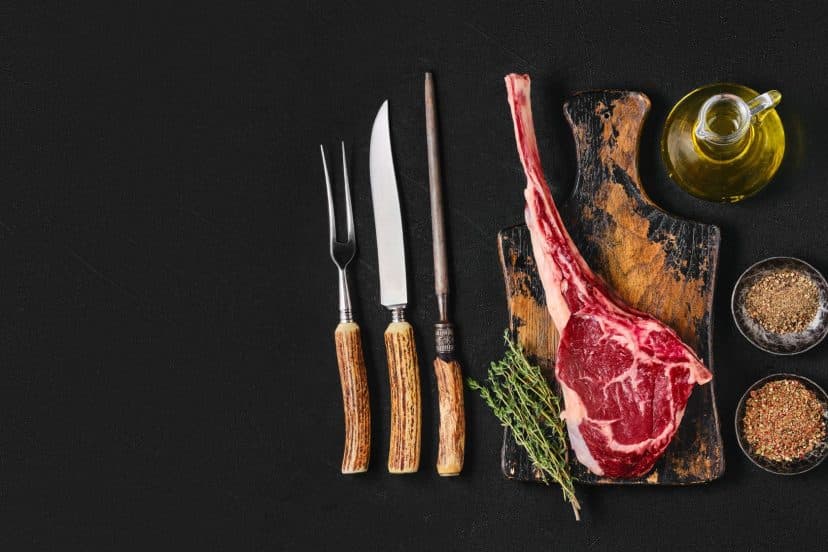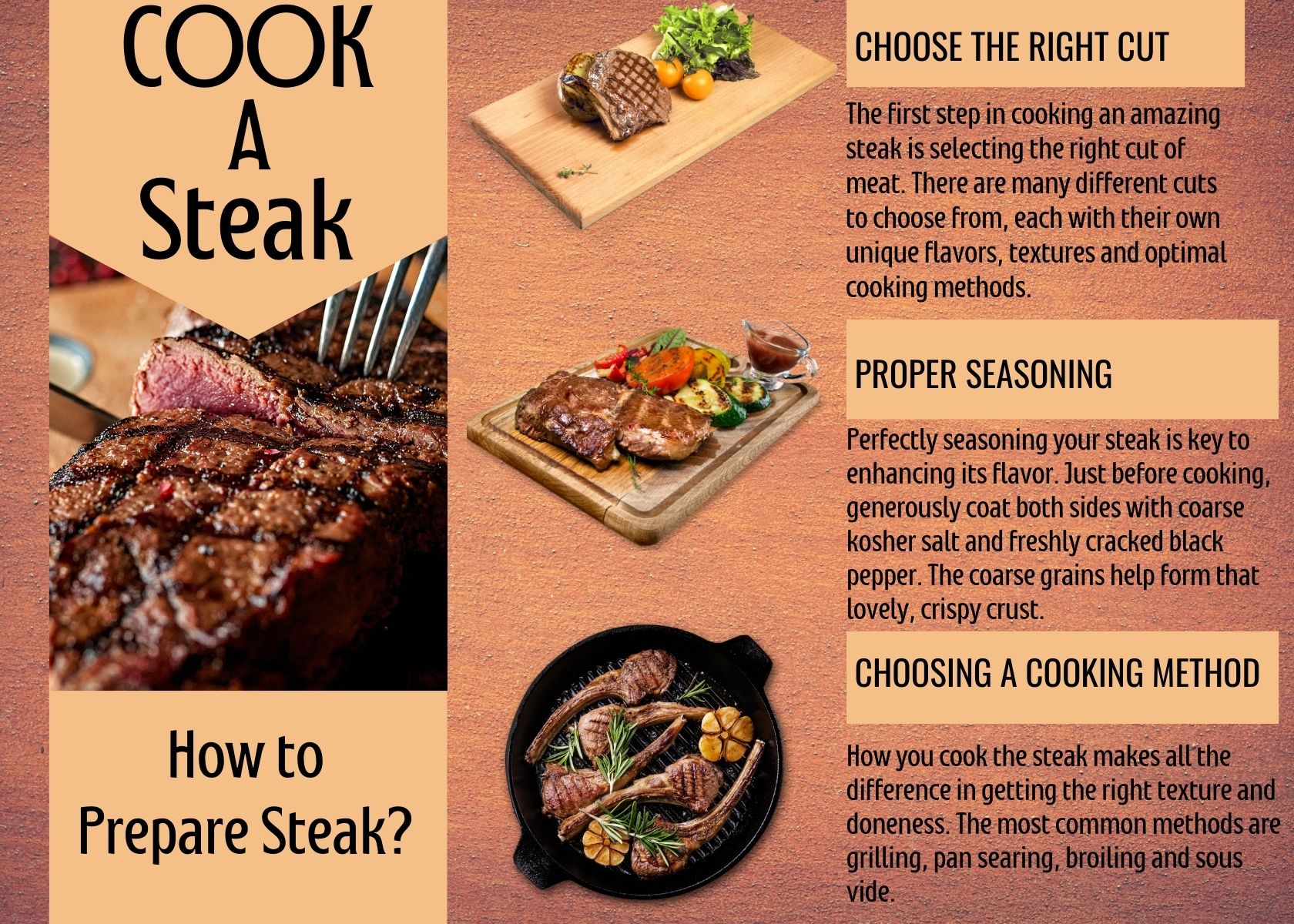How to Prepare Steak the Perfect Way?
Steak is a delicious and satisfying meal that is loved by many. However, preparing the perfect steak requires some skill and know-how to get the flavor, tenderness, and overall experience just right. In this comprehensive guide, we will walk through everything about how to prepare steak, from choosing the right cut of meat to cooking techniques and doneness levels.
With the right preparation, seasoning, and cooking, you can enjoy restaurant-quality steak in the comfort of your own home. So let’s get started!
Table of Contents
Choosing the Right Cut of Steak
The first step in cooking an amazing steak is selecting the right cut of meat. There are many different cuts to choose from, each with their own unique flavors, textures and optimal cooking methods.
Ribeye
Ribeye steak comes from the rib section and is known for its rich, beefy flavor and generous marbling. This marbling provides plenty of flavor and keeps the steak tender. The ribeye is a great choice if you prefer a tender, juicy and flavorful cut.
T-Bone
The T-bone contains both the strip and tenderloin cuts in one steak. You get the best of both worlds – the tenderness of the tenderloin and the robust flavor of the strip. This cut has a distinctive T-shaped bone that helps naturally tenderize the meat.
Strip Steak
Also known as a New York strip, this comes from the short loin primal cut. It offers a perfect balance of tenderness and rich flavor. Just be careful not to overcook, as this cut can become quite tough.
Flank Steak
Flank steak comes from the belly region and offers a lean cut that is budget-friendly. It has tons of intense beefy flavor but can be a little tougher. Be sure to slice against the grain after cooking to help tenderize.
Filet Mignon
The filet mignon comes from the tenderloin and is prized for its extreme tenderness. However, it contains less fat than other cuts so the flavor is more subdued. If you want a very tender, melt-in-your-mouth texture, filet mignon is perfect.
Hanger Steak
This underrated cut comes from the diaphragm muscle and delivers outstanding flavor. It’s very tender and juicy when prepared properly. For steak-lovers looking for something new, hanger steak is an excellent choice.
Once you’ve selected your preferred cut of steak, look for quality grading such as “USDA Choice” or “Prime” to get the best flavor and tenderness. Marbling is important – the more white fat streaks in the meat, the better.
Proper Seasoning For How to Prepare Steak
Perfectly seasoning your steak is key to enhancing its flavor. Just before cooking, generously coat both sides with coarse kosher salt and freshly cracked black pepper. The coarse grains help form that lovely, crispy crust.
Let the seasoned steak sit at room temperature for about 15-30 minutes before cooking. This helps the steak cook more evenly. The salt will also draw out some moisture to tenderize the meat further. Other great seasoning options include:
- Fresh or dried herbs like thyme, rosemary, or oregano
- Spices like garlic powder, onion powder, and smoked paprika
- Spice blends like Montreal Steak Seasoning
- Umami-boosting ingredients like soy sauce, Worcestershire sauce, and fish sauce
Don’t be afraid to get creative and come up with your own signature spice rubs. Just don’t overdo it; the flavor of quality steak should shine through. Here are some tips for marinating steak:
Use Acidic Ingredients
Ingredients like vinegar, citrus juice, or yogurt help tenderize the meat. The acids break down tough muscle fibers. 0Lemon juice, red wine vinegar, apple cider vinegar all work well.
Include Oil
Adding some oil helps the marinade coat and cling to the meat better. Olive oil, vegetable oil, or sesame oil are good options.
Season Generously
Use plenty of herbs, spices, garlic, etc to infuse big flavor. Options like rosemary, thyme, oregano, garlic, onion, chili powder all pair excellently with beef.
Consider Texture
Ingredients like ginger, mustard, soy sauce, Worcestershire sauce can help tenderize while adding flavor.
Marinate Overnight
Letting steak marinate for several hours or overnight allows the flavor to penetrate deeply into the meat. For thinner cuts, 2-4 hours may suffice.
Pierce the Meat
Poking holes with a fork helps the marinade absorb better internally. Don’t overdo it though.
Discard Used Marinade
Don’t reuse marinade after raw meat has soaked in it, as bacteria can spread. Boil used marinade to make a sauce.
Grill Quickly
Let steak sit out for 30 minutes before grilling. Grill over high direct heat for best sear.
With the right marinade and technique, you can make even inexpensive cuts taste amazing. Experiment with different ingredient combos to find your favorite marinade.
Choosing a Cooking Method For How to Prepare Steak
How you cook the steak makes all the difference in getting the right texture and doneness. The most common methods are grilling, pan searing, broiling and sous vide.
Grilling
This is a quintessential way to cook steak during warmer months. The high heat from the grill sears the outside while cooking the inside at the same time. Grilling gives a wonderful smoky charcoal flavor. Use a hot, clean grill and cook the steak over direct, high heat. Flip once halfway through cooking. Adding a pat of butter on top of the steak in the last few minutes boosts flavor.
Pan Searing
This stovetop method requires a heavy cast iron or stainless steel pan. Get the pan very hot before adding oil. Swirl the oil to coat the pan, then lay the steak in. Let it sear without moving for 2-3 minutes to get a nice crust. Flip and repeat on the other side. You can add butter, garlic, herbs or other flavors to baste the steak as it cooks.
Broiling
This hands-off technique uses direct radiant heat from above to quickly cook the steak. Place the steak on a broiler pan under the heating element in the oven. Broil on high heat for a few minutes per side until done. Keep a close eye to avoid burning.
Sous Vide
For the most precision, sous vide cooking immerses the steak in a water bath at a precise temperature. It cooks the meat evenly, edge-to-edge without overcooking. After sous vide, quickly sear the exterior to get a nice crust. No matter which cooking method you choose, use a digital thermometer to monitor the internal temperature and determine doneness. Shoot for pulling the steak off heat 5-10 degrees before it hits your desired temperature, as the residual heat will continue cooking it slightly.
Checking for Doneness
The doneness of steak comes down to personal preference. Here are guidelines for the various levels:
- Rare: 120-125 F – Cool, bright red center
- Medium Rare: 130-135 F – Warm, red center
- Medium: 140-145 F – Hot pink center
- Medium Well: 150-155 F – Small amount of pink in the center
- Well Done: 160+ F – No pink remaining, brown throughout
For the most tender, juicy steak, medium rare to medium is highly recommended. Well done steak often ends up tough and dry. Keep in mind that the temperature will rise about 5-10 degrees as the steak rests.
Use the finger test to gauge doneness before cutting into the steak. Rare feels like the fleshy part of your thumb when touched gently, medium rare feels like your palm pressed firmly, and well done feels hard as the tip of your nose.
Letting it Rest
This is one of the most overlooked steps when cooking steak, but it’s crucial for optimizing flavor and tenderness. After removing from heat, let the steak rest on a cutting board for about 5–10 minutes. This resting time allows the juices to redistribute evenly throughout the meat.
If you cut into it too soon, the juices will leak out onto the cutting board instead of staying inside. As it rests, flavors will concentrate and the steak fibers will relax after cooking. This amplifies the tenderness and flavor in each bite. Don’t skip this step if you want the best results.
Slicing Against the Grain
Cutting the steak properly makes a big difference in tenderness. Look closely at the direction of the meat fibers in the steak. Then, slice crosswise across those long grain lines instead of parallel with them. This severs the tough fibers, resulting in a much more tender chew.
Serving Suggestions
A perfectly cooked steak really doesn’t need much embellishment. Some simple sides like roasted potatoes, sautéed veggies or a fresh salad are perfect complements. For sauces and toppings, keep it simple to let the steak shine. Options include:
- Herb butter: melted butter with fresh herbs
- Chimichurri: herb, garlic and olive oil sauce
- Spicy mustard
- Blue cheese crumbles
- Caramelized onions
- Sautéed mushrooms
Conclusion
With this comprehensive guide, you have all the knowledge needed about how to prepare steak. Follow these tips for choosing the right cut, seasoning properly, cooking using the optimal method, and slicing and serving for the best results.
With a bit of practice, you’ll be able to enjoy restaurant-caliber steak anytime, right in your own home. Now get cooking and savor the flavor of perfectly prepared steak. Enjoy!
*We may earn a commission for the purchases made using our links. Please see our disclosure to learn more.





